Growing passion for lichens
It is not the stunning, large beauties of the plant world that are the passion of 41-year-old Dr. Gothamie Weerakoon but the humble but
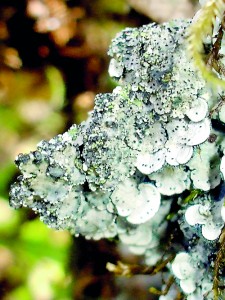
Coccocarpia
vital lichens that many people do not even notice.
As she delivered the ‘invitee address’ at the annual conference of the British Lichen Society on Thursday (January 9) at the University of Nottingham, it is not just a personal honour for her but also for Sri Lanka. For Dr. Weerakoon is part of an ‘exclusive’ group — one of just three Sri Lankan lichenologists.
Not only the special invite to talk on ‘South Asian lichen diversity, new findings and how lichens can be used as bio-indicators to monitor forest status in this region’ at the conference but also to be a consultant on two Asian lichen projects follow her “special findings” in the more or less virgin territory for lichens in the Knuckles Conservation Area. The two research projects on lichens in Vietnam and Borneo are being carried out by the Natural History Museum of London.
Having done her Ph.D research in the unchartered grounds for lower plants in the Knuckles area, she had discovered eight new endemic lichen species there. Her findings have been published in three scientific journals in 2012.
During further research after her doctorate, Dr. Weerakoon had found 43 more new endemic lichen species in Sri Lanka – 37 at Knuckles and six in the central mountains of Horton Plains.
This botanist has also set 374 new records with regard to lichens for Sri Lanka, of which 103 are new records for the Indian subcontinent and more than 20 are new records for Asia.
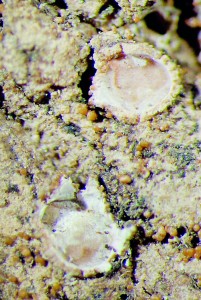
Chapsa Sri Lanka
Lichens by definition, she explains, are symbiotic organisms, mainly composed of a fungal partner (mycobiont) and one or more photosynthetic partners (photobiont) most often either a green algae or cyanobacterium. “They are minute stable ecological communities which can live on their own, while a high percentage of lichen-forming fungi carry out sexual reproduction,” she says.
It was by chance that she was “pushed” into studying lichens, “one of the least studied lower plant groups in Sri Lanka”, says Dr. Weerakoon looking back at the time when she was seeking funding for her Ph.D. It was only available for lichens. When she took up the study of lichens, they grew on her and “became the passion of my life”.
Now having successfully concluded her Ph.D from the Sri Jayewardenepura University, she is a post-doctoral researcher at the Department of Botany, Field Museum, Chicago, United States of America.
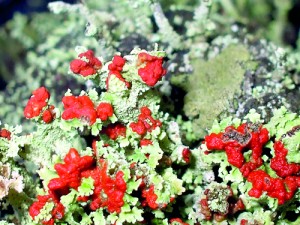
Cladonia
On holiday in Sri Lanka before leaving for Britain on January 4 to address eminent lichenologists, Dr. Weerakoon, when asked about her interest in botany goes back to her childhood to find the answers. Born in Matale, raised in Kurunegala and visiting her paternal relatives in Hewaheta, Kandy, she had been an outdoor girl most of the time.
Her father was an army officer and it was her mother as a housewife who kept a beautiful home and garden. “As a little girl, I used to collect withered leaves and flower petals and make greeting cards and wall paper,” she reminisces. Enjoy nature to the fullest she did, swimming in elas (streams) and playing in the mud of the kumburu and also among the piduru, with her mother laughingly saying that she was a “mada kariya” (someone who bathes in mud).
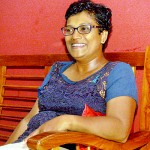
Dr. Gothamie Weerakoon on holiday in Sri Lanka. Pic by Nilan Maligaspe
Her tiny vegetable plot when she was 10 years old helped her to load kehel on a wheelbarrow and sell to neighbours, the income from which sometimes amounted to a princely Rs. 150 which went into her kete (piggy-bank).
Primary schooling was at Holy Family Convent, Kurunegala, followed by a stint at Janadhipathi Vidyalaya, Maharagama, with the Grade 5 scholarship examination success propelling her to Devi Balika Vidyalaya, Borella.
Her Bachelor’s Degree in Science she secured from the Open University of Sri Lanka, to which she pays tribute for fostering her research aptitude. Taking students away from the spoon-feeding and narrow
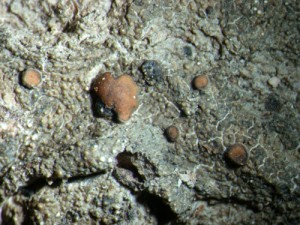
Malmidea papillosa new
teaching culture of the Advanced Level classrooms, she says the Open University gives undergraduates the freedom to choose a course of study of their liking and also the freedom to refer any book.
A Master’s in Natural Science followed from the University of Colombo topped by a Ph.D from the Department of Botany, Sri Jayewardenepura University, under the supervision of Prof. Chandrani Wijeyaratne.
With two young sons, it has been a tough, uphill task for Dr. Weerakoon. “My whole family including my husband and father made sacrifices for me to be able to achieve this,” she says, adding that with her Ph.D grant being just Rs. 12,000, she would tell her friends to buy her a book for her birthday and not fancy clothes or jewellery. She was also able to secure several scholarships from Kew Gardens in London, the British Museum in London, the Field Museum in Chicago and the Oregon State University to augment the local funding.
During her Ph.D she had narrowed down her studies to lichenology, as only two others had doctorates from Peradeniya University (Dr. Udeni Jayalal and Dr. Harris Peramunage) in this field.
While the earlier Ph.Ds focused on Horton Plains, Dr. Weerakoon turned her sights on the more difficult Knuckles Conservation Area,
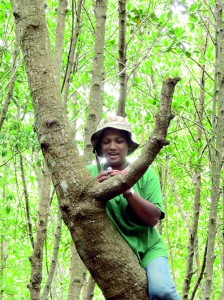
At home in the wilds during her Ph.D field studies
with the full support and guidance of Prof. Wijeyaratne.
From September 2008 to end 2011, field studies she did there for her Ph.D with two “very good” assistants, Nilantha and Vimukthi, in a wide area least studied with regard to lower plants.
The geological and geographical diversity of Knuckles fascinates her. It harbours many thousands of lichens within different locations, she says with awe, pointing out that while the easily accessible Horton Plains has only two mountain peaks, Knuckles has 35 peaks above 900 metres. The different sides of the same peak have a huge variation in the vegetation.
The humble folk in remote villages such as Meemure, Gombaniya and Kalupahana were the allies of this three-member team which would camp for around two-week stretches with only the basic necessities including sleeping bags, a few cooking pots and a small cooker. Their scrap meals would be a little rice or instant noodles and a curry such as tinned fish, with a dash of chutney or pickle for variety.
While engaged in intensive field work, the villagers passing-by would offer them pepper pods, a few chundus of rice, a hakuru-bevak (jaggery-half) or some beli-mal. She in turn would visit their humble homes bearing simple gifts such as sarongs, cheeththa or a few kilos of sugar. The villagers and us, “we were on the same page”, is her explanation.
Although the numerous bites of leeches caused them to be ill with high fever and they did see many reptiles, she and her assistants suffered only minor scratches from slipping and sliding and no major injury, she says thankfully, adding that nature has blessed her.
“My research was launched with a full heart and we didn’t cause any destruction to the environment during our field work,” she adds.
Now as she keeps her eye glued to the microscope studying and analysing many historical lichen collections, she pays tribute not only to Prof. Wijeyaratne who helped her in numerous ways during her doctoral studies but also to Dr. Patricia Wolseley of the Natural History Museum, London, Dr. Andre Aptroot of ABL Herbarium, Netherlands, and her current colleagues Dr. T. Lumbsch and Dr. R. Lucking of the Chicago Field Museum.
Two others whose encouragement and support she cannot forget are the Director-General of the Department of National Botanic Gardens, Dr. Siril Wijesundara and Prof. Veranja Karunaratne.
With patience needed aplenty during the long hours of peering into the microscope, studying 20-30 sections to ascertain the structure of lichens during her work in Chicago and telling her family that she would not be contactable for three-four days while doing so, Dr. Weerakoon also has a dream for Sri Lanka.
While she expects to “pay back” by sharing her expertise and experiences, she hopes that Sri Lanka would be able to develop a research team to take lichen studies much farther.
Sustainability is the key in such studies, according to her, as she gives a timely warning that lichens need to be documented as soon as possible as rapid development is causing a massive loss of biodiversity
Words from a true naturalist that need to be heeded without delay.


